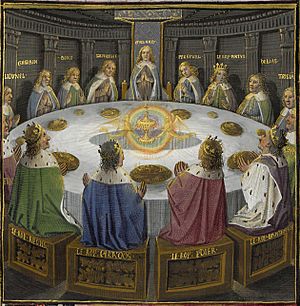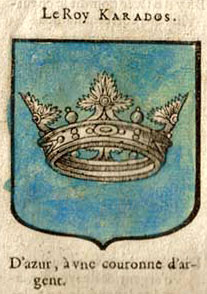Caradoc facts for kids

Caradoc Vreichvras (Welsh pronunciation: [kʰaˈɾɑːdak]; Modern Welsh: Caradog Freichfras, lit. Caradoc Strongarm) was a semi-legendary ancestor to the kings of Gwent. He may have lived during the 5th or 6th century. He is remembered in the Matter of Britain as a Knight of the Round Table, under the names King Carados and Carados Briefbras (French for "Carados Shortarm").
Contents
Identification and historicity
Though the name "Caradoc" and its various forms were by no means uncommon during the Middle Ages, it is probable some of the Caradocs referred to in Welsh genealogies and hagiographies such the Life of St. Tatheus are the same person.
Due to the name's prevalence considerable confusion exists about Caradoc's identity, both historical and literary. He may have become confused with the British hero Caratacus (the Latin form of Caradoc), Cerdic of Wessex and any number of British history's later Caradocs. His parentage varies from text to text; he is called the son of Llŷr Marini (possibly implying Llŷr) several times in the Mabinogion, and a probably-Breton legend found in the first Perceval continuation has a certain Caradoc the Elder as the father, furthering the obfuscation.
Some archaeologists interpret Caradog Freichfras as a plausible historical figure, also known as Caradoc ap Ynyr, who may have been the ruler of Gwent around the 6th century, and was based at Caerwent, the earlier Roman town of Venta Silurum. They interpret his name as a remembrance of the earlier hero Caratacus, implying a continuity of tradition from the pre-Roman culture of the Silures who occupied the same area in what is now south-east Wales, and which is also suggested by other material.
Welsh Triads and Monmouth's Caradocus
Caradoc appears in the Welsh Triads, where he is described as Arthur's chief elder at Celliwig in Cornwall and one of the three knights of the island of Britain; his horse is named as Lluagor ('Host-Splitter'). The same title—chief elder of Cornwall—is also given in Culhwch and Olwen, which lists "Gormant the son of Ricca (Arthur's brother by his mother's side; the Penhynev [chief elder] of Cornwall was his father)", a parallel to later stories of Gorlois of Cornwall. This can be read either with Ricca as the son of the chief elder, or the chief elder's name.
In Geoffrey of Monmouth's Historia Regum Britanniae, Caradocus is ruler of Cornwall under Octavius, who died during the reign of Emperor Magnus Maximus (383–388). The connection with Cornwall in the Triads may indicate that Monmouth used Caradoc as the basis for this character. Cornish antiquary Richard Carew instead places Caradocus as duke of Cornwall later, in 443, saying that Octavius tasked him with founding the University of Cambridge, and listing him as the predecessor of Gorlois.
French romances
In Arthurian legend, Caradoc is said to have been a knight of the Round Table during Uther Pendragon's time, but he joins other kings in rebellion when Arthur takes the throne. He is eventually reconciled with the young king and became one of his most trusted allies. Caradoc's wife, Tegau (teg: 'pretty'; eurfron: 'golden-breast'), is described as Caradoc's wife in the Livre de Carados (The Book of Caradoc) and Le Manteau Mal Taillé (The Badly Tailored Mantle), short stories dated to the end of the 12th century. In the Vulgate Mort Artu, he dies heroically in Arthur's final battle when he is killed by the Morded-appointed lord of Scotland, Heliades, whom he also kills after leading the rout of Irish mercenaries.
Other, unrelated characters named Caradoc or Carados also appear in the French Arthurian prose romances and later works inspired by them.
See also
- Bro Gwened


